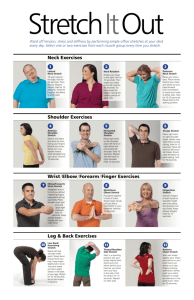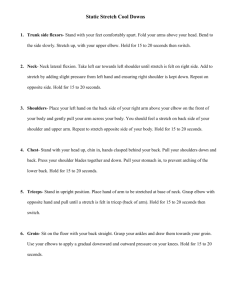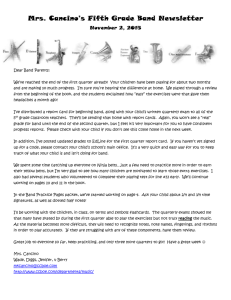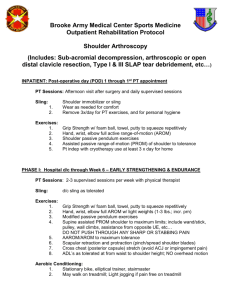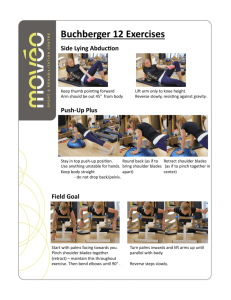Comparison of Picture, Video and Written Instruction on the Proper
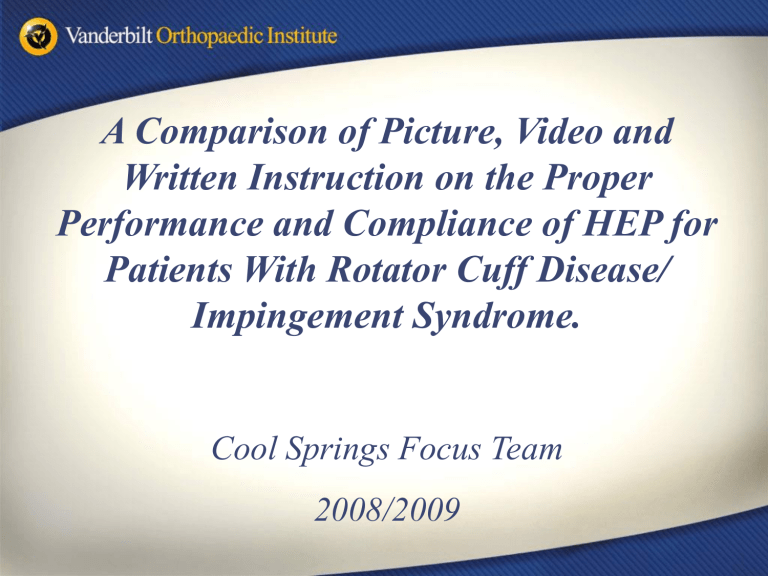
A Comparison of Picture, Video and
Written Instruction on the Proper
Performance and Compliance of HEP for
Patients With Rotator Cuff Disease/
Impingement Syndrome.
Cool Springs Focus Team
2008/2009
Research Question.
• What is the best method to deliver a Home Exercise
Program for patients with rotator cuff impingement? Will the use of video, pictures or descriptions be the most effective method to assure proper performance of exercises at home?
• This was a pilot study where no patient identifiers were used anytime during the process.
Background Information:
J. A. Reo, and V. S. Mercer
Effects of Live, Videotaped, or Written Instruction on
Learning an Upper-
Extremity Exercise
Program. Physical
Therapy, 2004 84: 622-633
• Exercise instruction is a vital part of Physical Therapy.
Correct teaching of the home exercise program is very important for several reasons such as:
– Improper performance may prevent patient from improving at the expected rate and may lead to further injury.
– Patient may lose motivation to continue program if they have pain with performance of a home exercise program.
• There is evidence in the literature that different formats of teaching may be more efficient in the acquisition of a new motor skill. Live and videotaped modeling are shown to be more effective than a handout alone for achieving accuracy in the performance of a basic exercise program.
Background Information:
• New technologies make it easier for patients to use other formats of instruction such as video
• Video instruction appears to be an efficient and successful way to instruct patients to a new Motor Skill.
Davis, M; Guadagnoli, M; Holcomb,
W. The efficacy of video feedback for learning the golf swing. Journal of
Sports Sciences. 2002 Vol 20(8) 615-
Sewall, LP., Reeve, TG., Day, RA.,
Effect of concurrent visual feedback on acquisition of a weightlifting skill.
Perceptual and Motor Skills. 1988
Dec; 67(3): 715-8
Procedure/Process/Methodology:
• Literature review was performed regarding styles of learning and better learning activities to assist with assimilation of new motor skills.
• Exercise program was developed. The program included 6 exercises to address rotator cuff impingement.
• Pictures and video of the exercises were taken and two handouts were produced. The first handout included pictures and descriptions of the exercises and the second included only descriptions without pictures. A video CD was also created with the exercises routine and audio instructions.
Exercise Selection
• Shoulder External Rotation T Band
• Shoulder Extension T band
• Shoulder Scapular retraction T band
• Wand External Rotation
• Wand Flexion
• Sleeper Stretch
Shoulder T band External Rotation:
With T band secured and at navel height, hold T band with affected arm across from body. Rotate arm outward, with elbow tucked in your side, until perpendicular to your body. Let it return to the starting position and repeat 10 times.
Shoulder Scapular retraction T band:
With T band secured and at navel height, hold T band in both hands with thumbs pointing up.
Start with arms straight and T band pulled tight.
Pinch shoulder blades together and pull T Band with elbows maintained at 90 degrees. Pull Arms to chest height and maintain proper posture.
Repeat 10 times.
Shoulder Extension T band:
With T band secured and at navel height, hold T band in both hands with thumbs pointing up. Start with arms straight and T band pulled tight. Pinch shoulder blades together and bring hands slightly past hips while keeping elbows straight. Repeat 10 times.
Sleeper Stretch:
Lie on your involved side with your arm at 90 degrees angle from your body. Keep your elbow bent at 90 degrees angle and gently push your forearm down toward the table with the opposite hand. Hold for 30 seconds. Repeat 10 times
Wand External Rotation:
Lie on back with arm away from your body on a
45 degree angle and elbow bent at 90 degrees.
Place small towel roll under elbow. Place one end of cane on palm of hand with thumb pointing toward head. and use the other hand to gently push your arm back until you feel a stretch on the front of your shoulder. Hold 5 seconds. Repeat 10 times. Forearm should be parallel with the floor.
Wand Flexion:
Lie on your back with your knee supported on a pillow to decrease stress on your spine. Position your hands with palms facing in and thumbs up.
Place a wand between your thumbs and index fingers of both hands. Lift your arms over your head until you feel a stretch in your shoulders.
Hold 5 seconds and come out of the stretch. Repeat
10 times.
Procedure/Process/Methodology: Video
Procedure/Process/Methodology:
• The group developed and assessment tool to determine patient’s adherence to proper techniques following a preestablished criteria.
• Patients were identically instructed on the performance of the 6 exercises after their initial evaluation. They randomly received one of the handouts or the video CD. During their first follow up visit, the performance of the exercises was evaluated using the assessment tool specially developed for the study and a score was determined
• The results of each group were compared for determination of best performance of exercise program.
Exercise Program Performance
Worksheet
Patient ID #
Wand Flexion:
1.
Lying on back ( )
2.
Elbows straight ( )
3.
Hold Cane Using thumbs ( )
4.
Thumbs pointing up ( )
5.
Raise arm until feel a stretch in the front of your shoulder. ( )
6.
Hold 10 seconds/ relax ( )
7.
Repeat ( )
(_______/7)
Wand External Rotation:
1.
Lying on back ( )
2.
Elbows away from body at 45 degrees angle ( )
3.
Elbow bent at 90 degree angle, ( )
4.
Small towel roll under elbow. ( )
5.
Cane in palm of hand with thumb pointing toward head ( )
6.
Use hand to gently push arm back until you feel a stretch in the front of your shoulder. ( )
7.
Hold 10 seconds/ Relax ( )
8.
Repeat ( )
(______/8)
Sleeper Stretch:
1.
Lie on your involved side ( )
2.
Shoulder at a 90 degree angle from your body. ( )
3.
Elbow at a 90 degree angle ( )
4.
Gently push your forearm down toward the table with your opposite hand Until you feel a stretch. ( )
5.
Hold this stretch for 30 seconds ( )
6.
Repeat 10 times ( )
(_______/6)
Scapular Retraction:
1.
Theraband positioned at naval height wrapped around secure post ( )
2.
Hold theraband in both hands with thumbs pointing up. ( )
3.
Start with arms straight and theraband pulled tight. ( )
4.
Keeping shoulder blades pinched pull theraband with elbows at 90 degrees and kept into side. ( )
5.
Relax and Repeat 10 times ( )
(_____/5)
Scapular retraction/ Shoulder Extension:
1.
Theraband positioned at naval height wrapped around secure post ( )
2.
Hold theraband in both hands with palms facing down. ( )
3.
Start with elbows straight and theraband pulled tight. ( )
4.
Pinch shoulder blades together ( )
5.
Extend Shoulders bringing hands positioned slightly past hips keeping elbows straight. ( )
6.
Relax and Repeat 10 times ( )
(_____/6)
External Rotation:
1.
Theraband positioned at naval height wrapped around secure post ( )
2.
Elbow bent at 90 degrees ( )
3.
Hold theraband in hand with thumb pointing up. ( )
4.
Rotate arm outward with elbow maintained at 90 degrees ( )
5.
Keep elbow against your body. ( )
6.
Keeping shoulder blades pinched pull theraband with elbows at 90 degrees and kept into side. ( )
7.
Relax and Repeat 10 times ( )
(_____/7)
Results
• The group produced 2 handouts and a CD with videos with identical exercises commonly used for the treatment of rotator cuff impingement. We also developed an exercise assessment tool to be used for evaluation of proper performance of exercises instructed.
• 8 patients received the Home Exercise Program divided in 3 formats: 2 patients received written descriptions, 4 patients received pictures and descriptions and 2 patients received the video format.
Results
• The patients that received the written format performed the worse. They only scored 24 points out of 39 points possible in average on the exercise performance assessment tool.
• The patients that received video and pictures/descriptions scored similarly. The picture and description group scored
36. 25/39 and the video group scored 36/39.
Assessment of results
• Video and picture/ descriptions format were more successful than simple descriptions in addressing learning needs of patients with rotator cuff impingement.
• Results were affected and could be because of the small sample of patients and the fact that some of the patients were not reviewing exercises at home.
Assessment of results
• New interview tool and guidelines will have to be developed to address patient’s compliance and if they reviewed the exercises to assure proper adherence to protocol.
• The small sample of patients shows promising data in favor of video and picture/descriptions format.
Recommendations
• A new assessment tool will be developed along with guidelines to address patient’s compliance and if patient’s reviewed the exercises at home to assure proper adherence to protocol.
• We will continue to collect data regarding learning styles for another year. The purpose is to collect more significant numbers to determine what format for home exercise program is more efficient.
Recommendations
• We will determine if patients are reviewing the exercises at home prior to reassessment. Patients that do not meet the criteria will be eliminated from the study.
• The results of this study may be used to modify and/or enhance existing outpatient rehabilitation guidelines regarding HEP.
• New handouts and videos will be produced to address shoulder and other different diagnosis.
